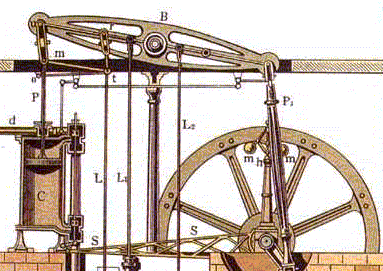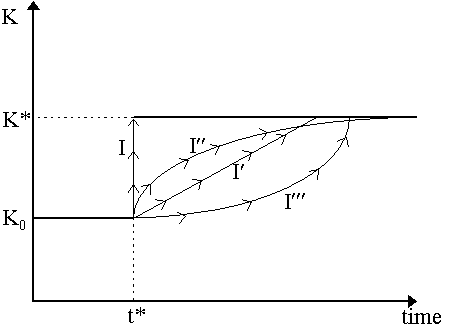|
________________________________________________________
________________________________________________________ Contents (1) Introduction: Capital versus
Investment Introduction: Capital versus Investment What is investment? Strictly speaking, investment is the change in capital stock during a period. Consequently, unlike capital, investment is a flow term and not a stock term. This means that while capital is measured at a point in time, while investment can only be measured over a period of time. If we ask "what is capital right now?", we might get an answer along the lines of $10 trillion. But if we ask "what is investment right now?", this cannot be answered. The quantity of a flow always depends on the period in consideration. Thus, we can answer "what is investment this month?" (and might be told it is $10 million) or "what is investment this year?" (and might be told $1 billion). We can calculate the investment flow in a period as the difference between the capital stock at the end of the period and the capital stock at the beginning of the period. Thus, the investment flow at time period t can be defined as:
where Kt is the stock of capital at the end of period t and Kt-1 is the stock of capital at the end of period t-1 (and thus at the beginning of period t). How is the the theory of investment different from the theory of capital? If all capital is circulating capital, so that it is completely used up within a period, then no capital built up during the previous period can be brought over into next period. In this special case, the theory of capital and the theory of investment become one and the same thing. With fixed capital, the story is different -- and more complicated as there seems to be two decisions that must be addressed: the amount of capital and the amount of investment. These are different decisions. One is about the desired level of capital stock. The other is about the desired rate of investment flow. The decisions governing one will inevitably affect the other, but it is not necessarily the case that one is reducible to the other. There are effectively two ways of thinking about investment. At the risk of annoying some people, we shall refer to these as the "Hayekian" and "Keynesian" perspectives. The Hayekian perspective conceives of investment as the adjustment to equilibrium and thus the optimal amount of investment is effectively a decision on the optimal speed of adjustment. A firm may decide it needs a factory (the "capital stock" decision), but its decision on how fast to build it, how much to spend each month building it, etc. -- effectively, the "investment" decision -- is a separate consideration. Naturally, the capital decision influences the investment decision: a firm which has $10 billion of capital and decides that it needs $15 billion of capital, therefore requires investment of $5 billion. But if this adjustment can be done "instantly", then there is really no actual investment decision to speak of. We just change the capital stock automatically. The capital decision governs everything. However, if for some reason, instant adjustment is not possible, then the investment story begins to matter. How do we distribute this $5 billion adjustment? Do we invest in an even flow over time, e.g. $1 billion this week, another $1 billion next week, and so on? Or do we invest in descending increments, e.g. invest $1 billion this week, $500 million next week, $300 million the week after that, etc. and approach the $5 billion mark asymptotically? Or should we invest in ascending increments, e.g. $10 million this week, $100 million next week, etc.? Delivery costs, changing prices of suppliers, fluctuating interest rates and financing costs, and other such considerations, make some adjustment processes more desirable than others. These different patterns of "approaching" the desired $5 billion adjustment in capital stock and the considerations that enter into determining which adjustment pattern to follow is what lies at the heart of the Hayekian approach to investment theory. The Hayekian approach is shown heuristically in Figure 1, where we start at capital stock K0 and then, at t*, we suddenly change our desired capital stock from K0 to K*. Figure 1 depicts four alternative investment paths from K0 towards K*. Path I represents "instant" adjustment type of investment (i.e. all investment happens at once at t* and no more investment afterwards). Path I˘ represents an "even flow" adjustment path, with investment happening at a steady rate after t* until K* is reached. Path I˘ ˘ is the asymptotic investment path (gradually declining investment), while path I˘ ˘ ˘ depicts a gradually increasing investment path. All paths, except for the first instant one, imply that "investment" flows will be happening during the periods that follow t*. Properly speaking, then, investment theory in the Hayekian perspective is concerned with analyzing and comparing paths such as I˘ , I˘ ˘ and I˘ ˘ ˘ .
The "Keynesian" approach places far less emphasis on the "adjustment" nature of investment. Instead, they have a more "behavioral" take on the investment decision. Namely, the Keynesian approach argues that investment is simply what capitalists "do". Every period, workers consume and capitalists "invest" as a matter of course. This leads Keynesians to underplay the capital stock decision. This does not mean that Keynesians ignore the fact that investment is defined as a change in capital stock. Rather, they believe that the main decision is the investment decision; the capital stock just "follows" from the investment patterns rather than being an important thing that needs to be "optimally" decided upon beforehand. Thus, when businesses make investment decisions, they do not have an "optimal capital stock" in the back of their mind. They are more concerned as to what is the optimal amount of investment for some particular period. For Keynesians, then, optimal investment not about "optimal adjustment" but rather about "optimal behavior". In economics, the "Keynesian" perspective has a longer history than the "Hayekian" one precisely because so many of the early economists, from Turgot (1766) onwards, concentrated on circulating capital rather than fixed capital. With circulating capital, the question of the "optimal capital stock" cannot come up; there is only the "optimal investment" decision (i.e. capital per period). The first theory of investment we consider here, Irving Fisher's (1930) theory, follows these lines. Fisher's theory was originally conceived as a theory of capital, but as he assumes all capital is circulating, then it is just as proper to conceive of it as a theory of investment. John Maynard Keynes (1936) followed suit. Or, rather, in his theory, Keynes made much of the investment decision but was quiet about the underlying fixed capital. As such, Keynesian macroeconomics swept the issue of the changing capital stocks under the rug -- where it stayed until it was dug up by growth theorists many years later. Modern Neo-Keynesian and Post Keynesian theorists have attempted to insert capital stocks into Keynesian theory in order to obtain a "more complete" macroeconomic theory, but have generally adhered to Keynes's strategy of placing the investment decision as the centrepiece and subordinating capital stock considerations to it. Fixed capital, and thus the optimal capital stock, was an important feature in the work of John Bates Clark (1899), Frank Ramsey (1928) and Frank H. Knight (1936, 1946). Or, propertly speaking, these theorists embraced the idea of a "permanent fund" of capital in the economy, and thus were naturally led to ask questions about its optimal "size". This was effectively what Neoclassical theorists such as Dale W. Jorgensen (1963) picked up in their theories. However, while elaborate on the determination of the optimal capital stock, these theories tended to skimp on the determination of the adjustment towards it, i.e. on investment. The great intermediate figure was Friedrich A. von Hayek (1941), who juggled with the concepts of fixed and circulating capital by conceiving of an optimal stock of fixed capital and of investment as the optimal adjustment towards it (an idea that Knut Wicksell (1898, 1901) had also toyed with). This was the notion picked up in later years by Abba Lerner (1944, 1953), Friedrich Lutz and Vera Lutz (1951), Trygve Haavelmo (1960) and the marginal adjustment cost theorists (Eisner and Strotz, Lucas, Treadway, Gould, etc.) The modern Neoclassical theory of investment stems largely from this tradition. In what follows, we shall go through a few points in each of these types of theories. We should point out now that our emphasis in on theories of the investment decision, in its more "production"-theoretic sense rather than a macroeconomic one. We are not concerned here with the theory of interest rates, in which investment theory plays an important role, as that would entangle us in the details of the monetary theories of Wicksell, Robertson, Ohlin, Hayek, Keynes and others. We treat this elsewhere. There is no comprehensive text on investment theory. The following treatises, however, contain good surveys of substantial areas of investment theory: Friedrich Lutz and Vera Lutz (1951), Trygve Haavelmo (1960), Jack Hirschleifer (1970), Andrew Abel (1979) and Mark Precious (1987). Also recommended is the collection edited by Paul Davidson (1993). |
All rights reserved, Gonçalo L. Fonseca


